Analysis of Ethical Theories and Governance in a Business Context
VerifiedAdded on 2022/09/18
|12
|3199
|16
Case Study
AI Summary
This assignment analyzes a case study focused on ethics and governance within a business context. It examines the application of ethical theories, including egoism, utilitarianism, and deontology, to the actions of key individuals within a company. The assignment explores the ethical dilemmas faced by managers, particularly in situations involving financial reporting and employee treatment. The analysis includes the application of the AAA Ethical Decision-Making Model to guide decision-making processes and the role of the APES 110 Code of Ethics for Professional Accountants in ensuring ethical conduct. The case study highlights the importance of ethical principles in maintaining business integrity, stakeholder trust, and compliance with legal and professional standards, with a focus on the responsibilities of management accountants and other professionals. The assignment provides a comprehensive overview of the ethical challenges and frameworks relevant to business operations and leadership.
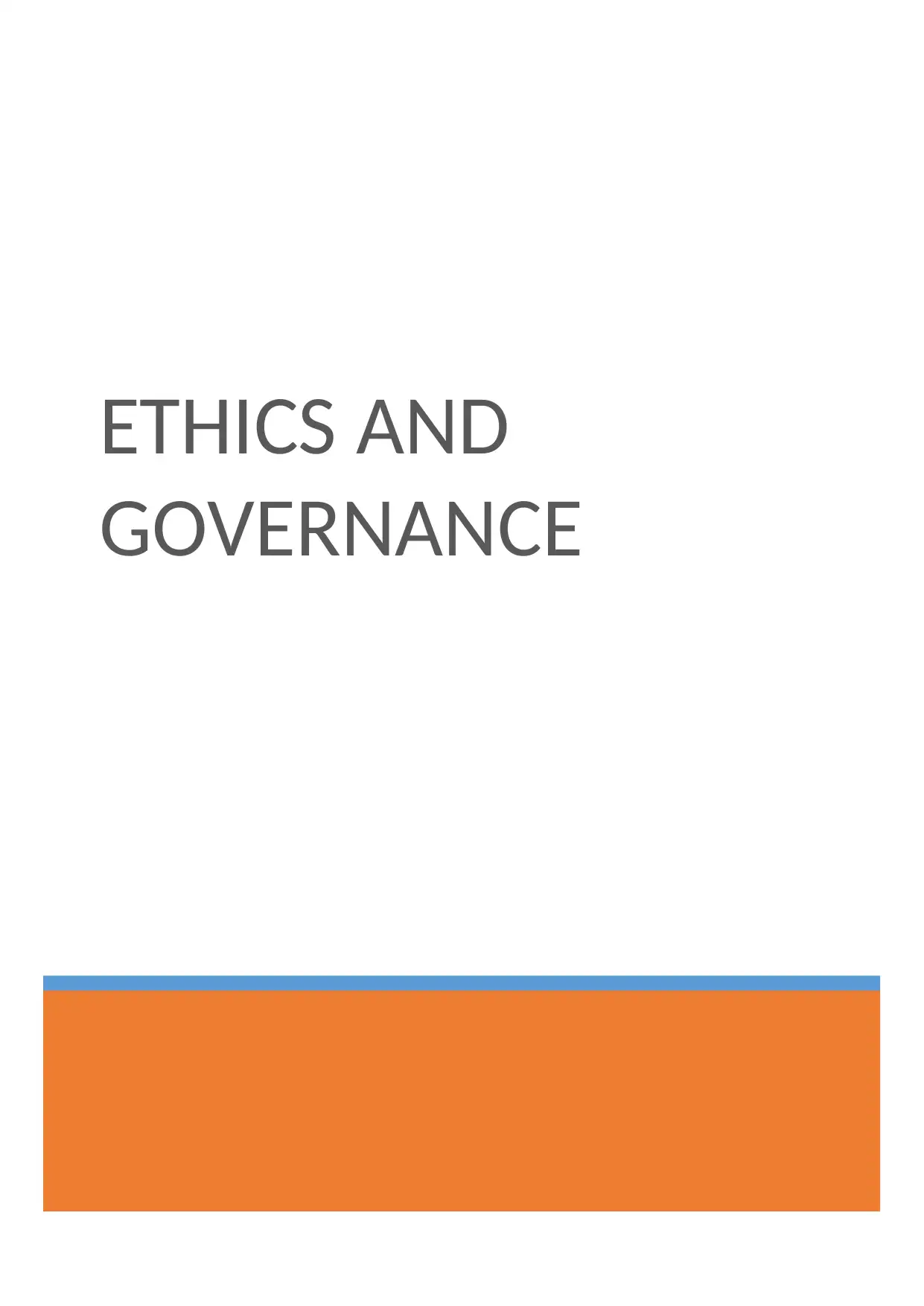
ETHICS AND
GOVERNANCE
GOVERNANCE
Paraphrase This Document
Need a fresh take? Get an instant paraphrase of this document with our AI Paraphraser
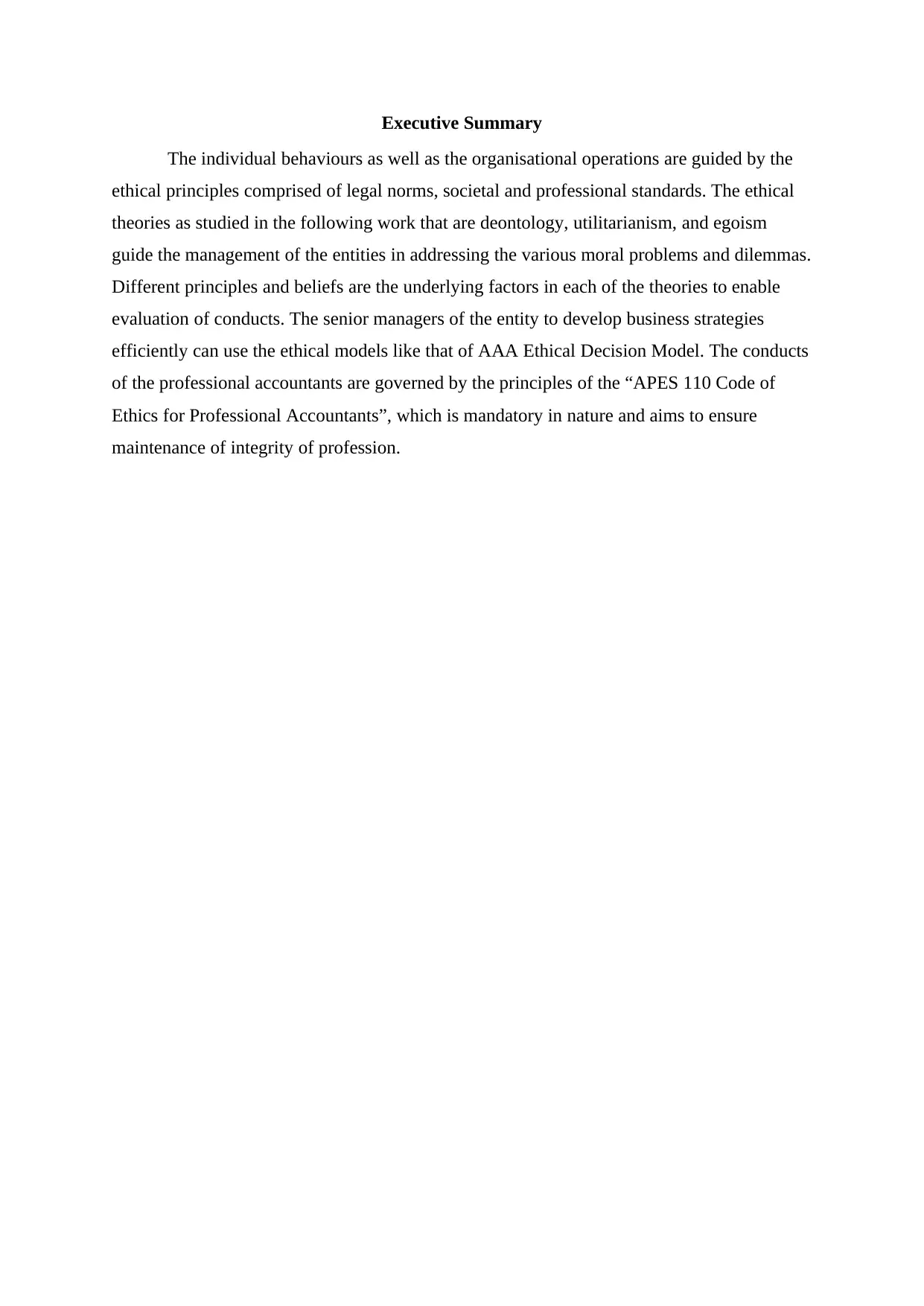
Executive Summary
The individual behaviours as well as the organisational operations are guided by the
ethical principles comprised of legal norms, societal and professional standards. The ethical
theories as studied in the following work that are deontology, utilitarianism, and egoism
guide the management of the entities in addressing the various moral problems and dilemmas.
Different principles and beliefs are the underlying factors in each of the theories to enable
evaluation of conducts. The senior managers of the entity to develop business strategies
efficiently can use the ethical models like that of AAA Ethical Decision Model. The conducts
of the professional accountants are governed by the principles of the “APES 110 Code of
Ethics for Professional Accountants”, which is mandatory in nature and aims to ensure
maintenance of integrity of profession.
The individual behaviours as well as the organisational operations are guided by the
ethical principles comprised of legal norms, societal and professional standards. The ethical
theories as studied in the following work that are deontology, utilitarianism, and egoism
guide the management of the entities in addressing the various moral problems and dilemmas.
Different principles and beliefs are the underlying factors in each of the theories to enable
evaluation of conducts. The senior managers of the entity to develop business strategies
efficiently can use the ethical models like that of AAA Ethical Decision Model. The conducts
of the professional accountants are governed by the principles of the “APES 110 Code of
Ethics for Professional Accountants”, which is mandatory in nature and aims to ensure
maintenance of integrity of profession.
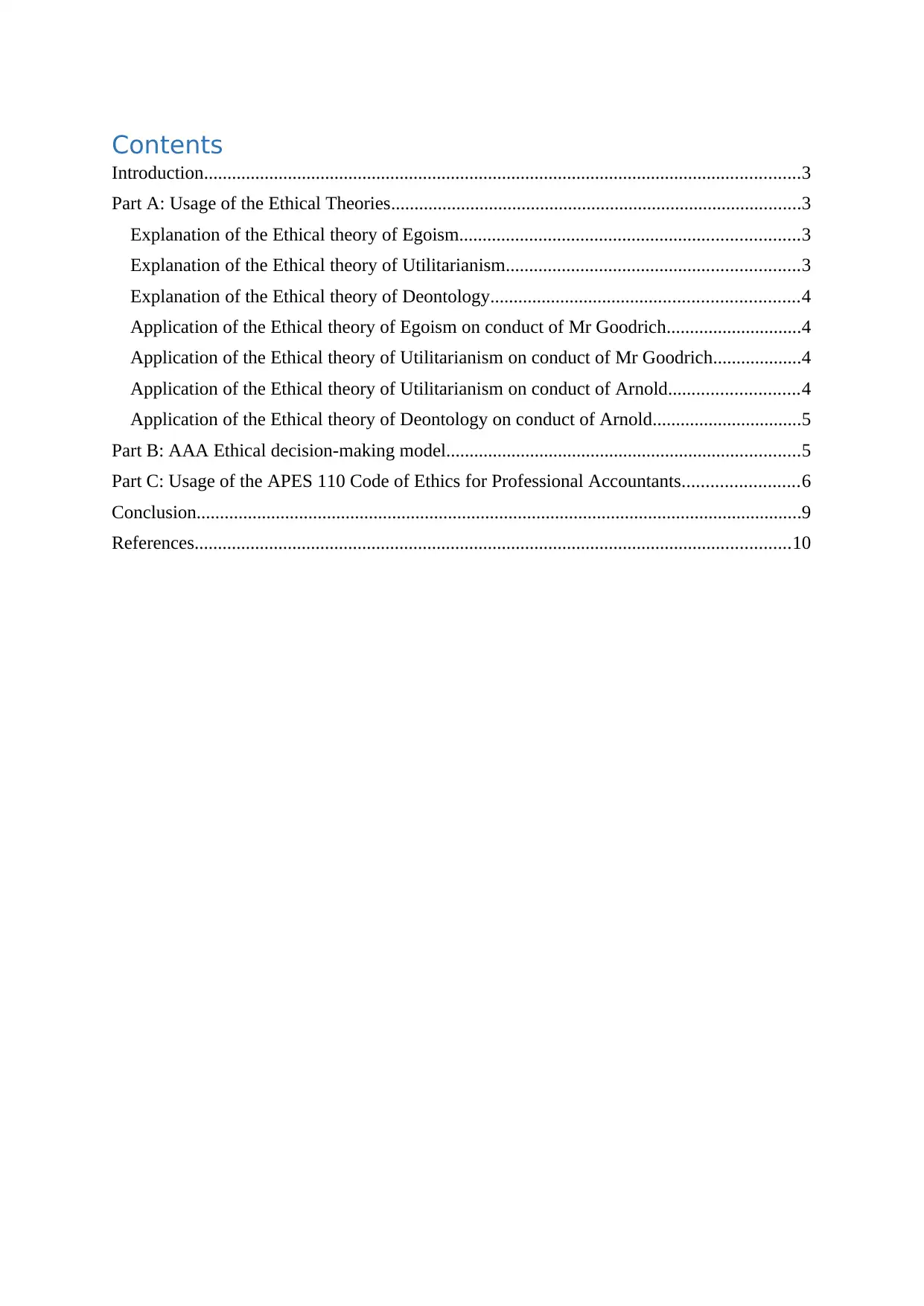
Contents
Introduction................................................................................................................................3
Part A: Usage of the Ethical Theories........................................................................................3
Explanation of the Ethical theory of Egoism.........................................................................3
Explanation of the Ethical theory of Utilitarianism...............................................................3
Explanation of the Ethical theory of Deontology..................................................................4
Application of the Ethical theory of Egoism on conduct of Mr Goodrich.............................4
Application of the Ethical theory of Utilitarianism on conduct of Mr Goodrich...................4
Application of the Ethical theory of Utilitarianism on conduct of Arnold............................4
Application of the Ethical theory of Deontology on conduct of Arnold................................5
Part B: AAA Ethical decision-making model............................................................................5
Part C: Usage of the APES 110 Code of Ethics for Professional Accountants.........................6
Conclusion..................................................................................................................................9
References................................................................................................................................10
Introduction................................................................................................................................3
Part A: Usage of the Ethical Theories........................................................................................3
Explanation of the Ethical theory of Egoism.........................................................................3
Explanation of the Ethical theory of Utilitarianism...............................................................3
Explanation of the Ethical theory of Deontology..................................................................4
Application of the Ethical theory of Egoism on conduct of Mr Goodrich.............................4
Application of the Ethical theory of Utilitarianism on conduct of Mr Goodrich...................4
Application of the Ethical theory of Utilitarianism on conduct of Arnold............................4
Application of the Ethical theory of Deontology on conduct of Arnold................................5
Part B: AAA Ethical decision-making model............................................................................5
Part C: Usage of the APES 110 Code of Ethics for Professional Accountants.........................6
Conclusion..................................................................................................................................9
References................................................................................................................................10
⊘ This is a preview!⊘
Do you want full access?
Subscribe today to unlock all pages.

Trusted by 1+ million students worldwide
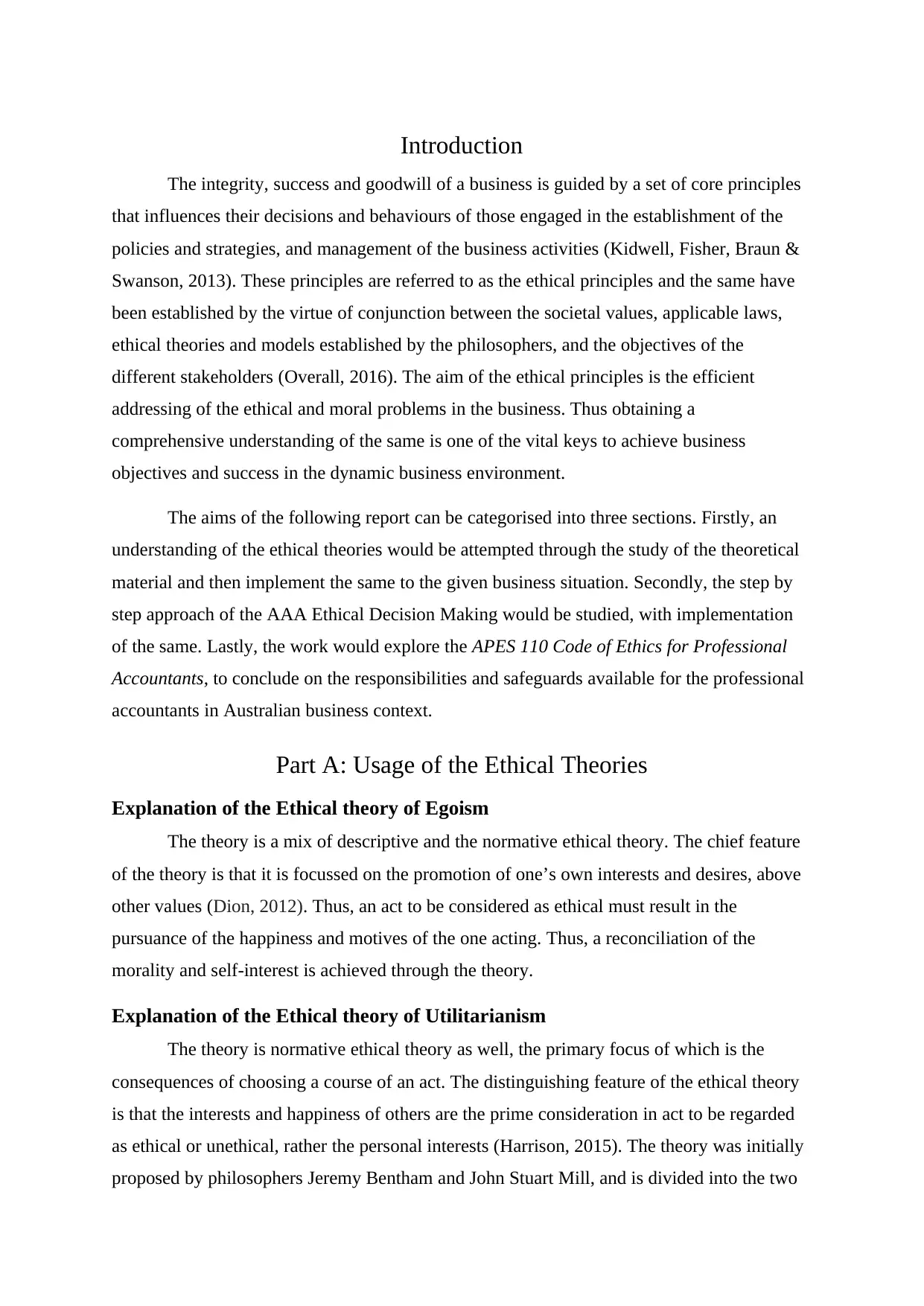
Introduction
The integrity, success and goodwill of a business is guided by a set of core principles
that influences their decisions and behaviours of those engaged in the establishment of the
policies and strategies, and management of the business activities (Kidwell, Fisher, Braun &
Swanson, 2013). These principles are referred to as the ethical principles and the same have
been established by the virtue of conjunction between the societal values, applicable laws,
ethical theories and models established by the philosophers, and the objectives of the
different stakeholders (Overall, 2016). The aim of the ethical principles is the efficient
addressing of the ethical and moral problems in the business. Thus obtaining a
comprehensive understanding of the same is one of the vital keys to achieve business
objectives and success in the dynamic business environment.
The aims of the following report can be categorised into three sections. Firstly, an
understanding of the ethical theories would be attempted through the study of the theoretical
material and then implement the same to the given business situation. Secondly, the step by
step approach of the AAA Ethical Decision Making would be studied, with implementation
of the same. Lastly, the work would explore the APES 110 Code of Ethics for Professional
Accountants, to conclude on the responsibilities and safeguards available for the professional
accountants in Australian business context.
Part A: Usage of the Ethical Theories
Explanation of the Ethical theory of Egoism
The theory is a mix of descriptive and the normative ethical theory. The chief feature
of the theory is that it is focussed on the promotion of one’s own interests and desires, above
other values (Dion, 2012). Thus, an act to be considered as ethical must result in the
pursuance of the happiness and motives of the one acting. Thus, a reconciliation of the
morality and self-interest is achieved through the theory.
Explanation of the Ethical theory of Utilitarianism
The theory is normative ethical theory as well, the primary focus of which is the
consequences of choosing a course of an act. The distinguishing feature of the ethical theory
is that the interests and happiness of others are the prime consideration in act to be regarded
as ethical or unethical, rather the personal interests (Harrison, 2015). The theory was initially
proposed by philosophers Jeremy Bentham and John Stuart Mill, and is divided into the two
The integrity, success and goodwill of a business is guided by a set of core principles
that influences their decisions and behaviours of those engaged in the establishment of the
policies and strategies, and management of the business activities (Kidwell, Fisher, Braun &
Swanson, 2013). These principles are referred to as the ethical principles and the same have
been established by the virtue of conjunction between the societal values, applicable laws,
ethical theories and models established by the philosophers, and the objectives of the
different stakeholders (Overall, 2016). The aim of the ethical principles is the efficient
addressing of the ethical and moral problems in the business. Thus obtaining a
comprehensive understanding of the same is one of the vital keys to achieve business
objectives and success in the dynamic business environment.
The aims of the following report can be categorised into three sections. Firstly, an
understanding of the ethical theories would be attempted through the study of the theoretical
material and then implement the same to the given business situation. Secondly, the step by
step approach of the AAA Ethical Decision Making would be studied, with implementation
of the same. Lastly, the work would explore the APES 110 Code of Ethics for Professional
Accountants, to conclude on the responsibilities and safeguards available for the professional
accountants in Australian business context.
Part A: Usage of the Ethical Theories
Explanation of the Ethical theory of Egoism
The theory is a mix of descriptive and the normative ethical theory. The chief feature
of the theory is that it is focussed on the promotion of one’s own interests and desires, above
other values (Dion, 2012). Thus, an act to be considered as ethical must result in the
pursuance of the happiness and motives of the one acting. Thus, a reconciliation of the
morality and self-interest is achieved through the theory.
Explanation of the Ethical theory of Utilitarianism
The theory is normative ethical theory as well, the primary focus of which is the
consequences of choosing a course of an act. The distinguishing feature of the ethical theory
is that the interests and happiness of others are the prime consideration in act to be regarded
as ethical or unethical, rather the personal interests (Harrison, 2015). The theory was initially
proposed by philosophers Jeremy Bentham and John Stuart Mill, and is divided into the two
Paraphrase This Document
Need a fresh take? Get an instant paraphrase of this document with our AI Paraphraser
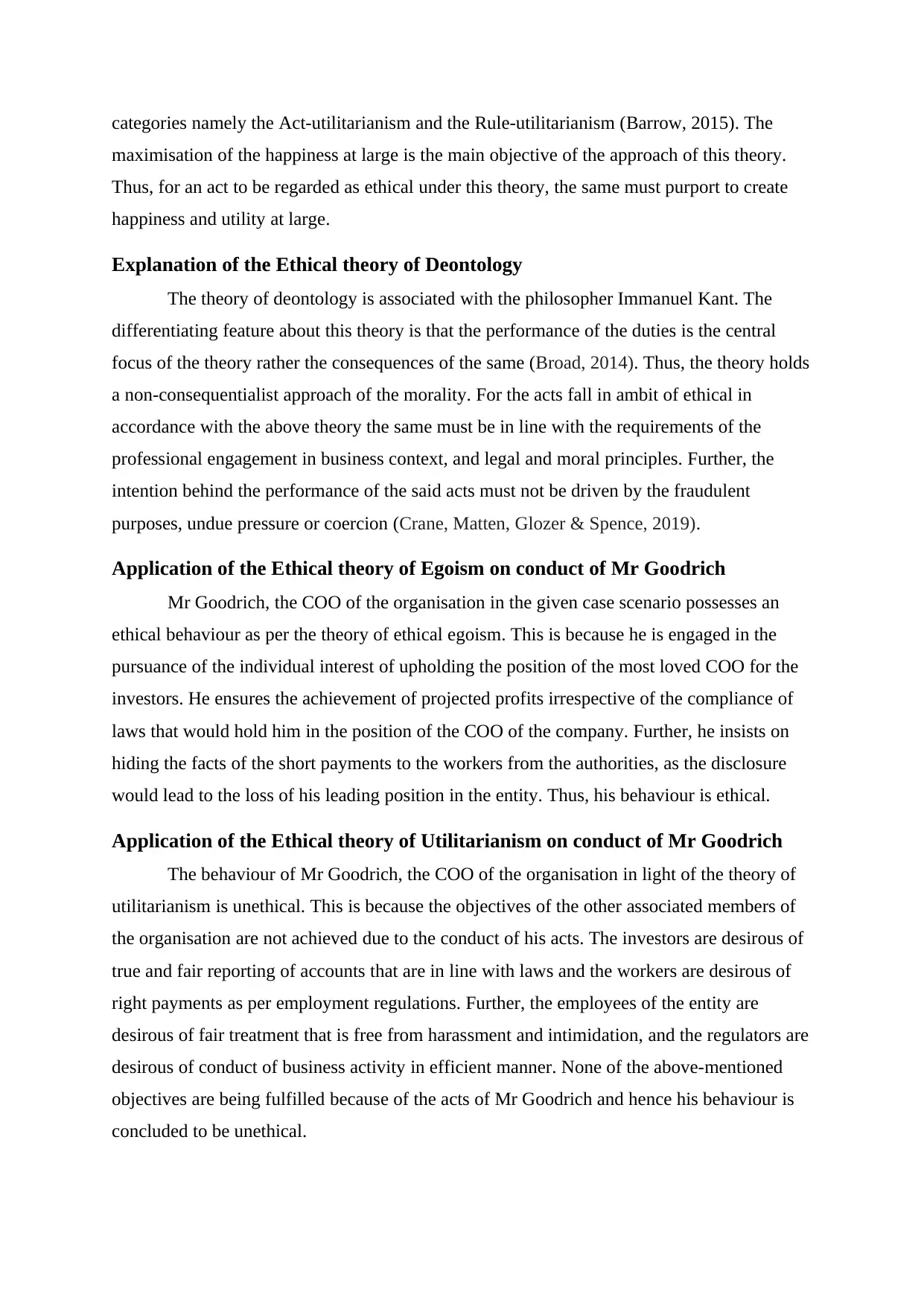
categories namely the Act-utilitarianism and the Rule-utilitarianism (Barrow, 2015). The
maximisation of the happiness at large is the main objective of the approach of this theory.
Thus, for an act to be regarded as ethical under this theory, the same must purport to create
happiness and utility at large.
Explanation of the Ethical theory of Deontology
The theory of deontology is associated with the philosopher Immanuel Kant. The
differentiating feature about this theory is that the performance of the duties is the central
focus of the theory rather the consequences of the same (Broad, 2014). Thus, the theory holds
a non-consequentialist approach of the morality. For the acts fall in ambit of ethical in
accordance with the above theory the same must be in line with the requirements of the
professional engagement in business context, and legal and moral principles. Further, the
intention behind the performance of the said acts must not be driven by the fraudulent
purposes, undue pressure or coercion (Crane, Matten, Glozer & Spence, 2019).
Application of the Ethical theory of Egoism on conduct of Mr Goodrich
Mr Goodrich, the COO of the organisation in the given case scenario possesses an
ethical behaviour as per the theory of ethical egoism. This is because he is engaged in the
pursuance of the individual interest of upholding the position of the most loved COO for the
investors. He ensures the achievement of projected profits irrespective of the compliance of
laws that would hold him in the position of the COO of the company. Further, he insists on
hiding the facts of the short payments to the workers from the authorities, as the disclosure
would lead to the loss of his leading position in the entity. Thus, his behaviour is ethical.
Application of the Ethical theory of Utilitarianism on conduct of Mr Goodrich
The behaviour of Mr Goodrich, the COO of the organisation in light of the theory of
utilitarianism is unethical. This is because the objectives of the other associated members of
the organisation are not achieved due to the conduct of his acts. The investors are desirous of
true and fair reporting of accounts that are in line with laws and the workers are desirous of
right payments as per employment regulations. Further, the employees of the entity are
desirous of fair treatment that is free from harassment and intimidation, and the regulators are
desirous of conduct of business activity in efficient manner. None of the above-mentioned
objectives are being fulfilled because of the acts of Mr Goodrich and hence his behaviour is
concluded to be unethical.
maximisation of the happiness at large is the main objective of the approach of this theory.
Thus, for an act to be regarded as ethical under this theory, the same must purport to create
happiness and utility at large.
Explanation of the Ethical theory of Deontology
The theory of deontology is associated with the philosopher Immanuel Kant. The
differentiating feature about this theory is that the performance of the duties is the central
focus of the theory rather the consequences of the same (Broad, 2014). Thus, the theory holds
a non-consequentialist approach of the morality. For the acts fall in ambit of ethical in
accordance with the above theory the same must be in line with the requirements of the
professional engagement in business context, and legal and moral principles. Further, the
intention behind the performance of the said acts must not be driven by the fraudulent
purposes, undue pressure or coercion (Crane, Matten, Glozer & Spence, 2019).
Application of the Ethical theory of Egoism on conduct of Mr Goodrich
Mr Goodrich, the COO of the organisation in the given case scenario possesses an
ethical behaviour as per the theory of ethical egoism. This is because he is engaged in the
pursuance of the individual interest of upholding the position of the most loved COO for the
investors. He ensures the achievement of projected profits irrespective of the compliance of
laws that would hold him in the position of the COO of the company. Further, he insists on
hiding the facts of the short payments to the workers from the authorities, as the disclosure
would lead to the loss of his leading position in the entity. Thus, his behaviour is ethical.
Application of the Ethical theory of Utilitarianism on conduct of Mr Goodrich
The behaviour of Mr Goodrich, the COO of the organisation in light of the theory of
utilitarianism is unethical. This is because the objectives of the other associated members of
the organisation are not achieved due to the conduct of his acts. The investors are desirous of
true and fair reporting of accounts that are in line with laws and the workers are desirous of
right payments as per employment regulations. Further, the employees of the entity are
desirous of fair treatment that is free from harassment and intimidation, and the regulators are
desirous of conduct of business activity in efficient manner. None of the above-mentioned
objectives are being fulfilled because of the acts of Mr Goodrich and hence his behaviour is
concluded to be unethical.
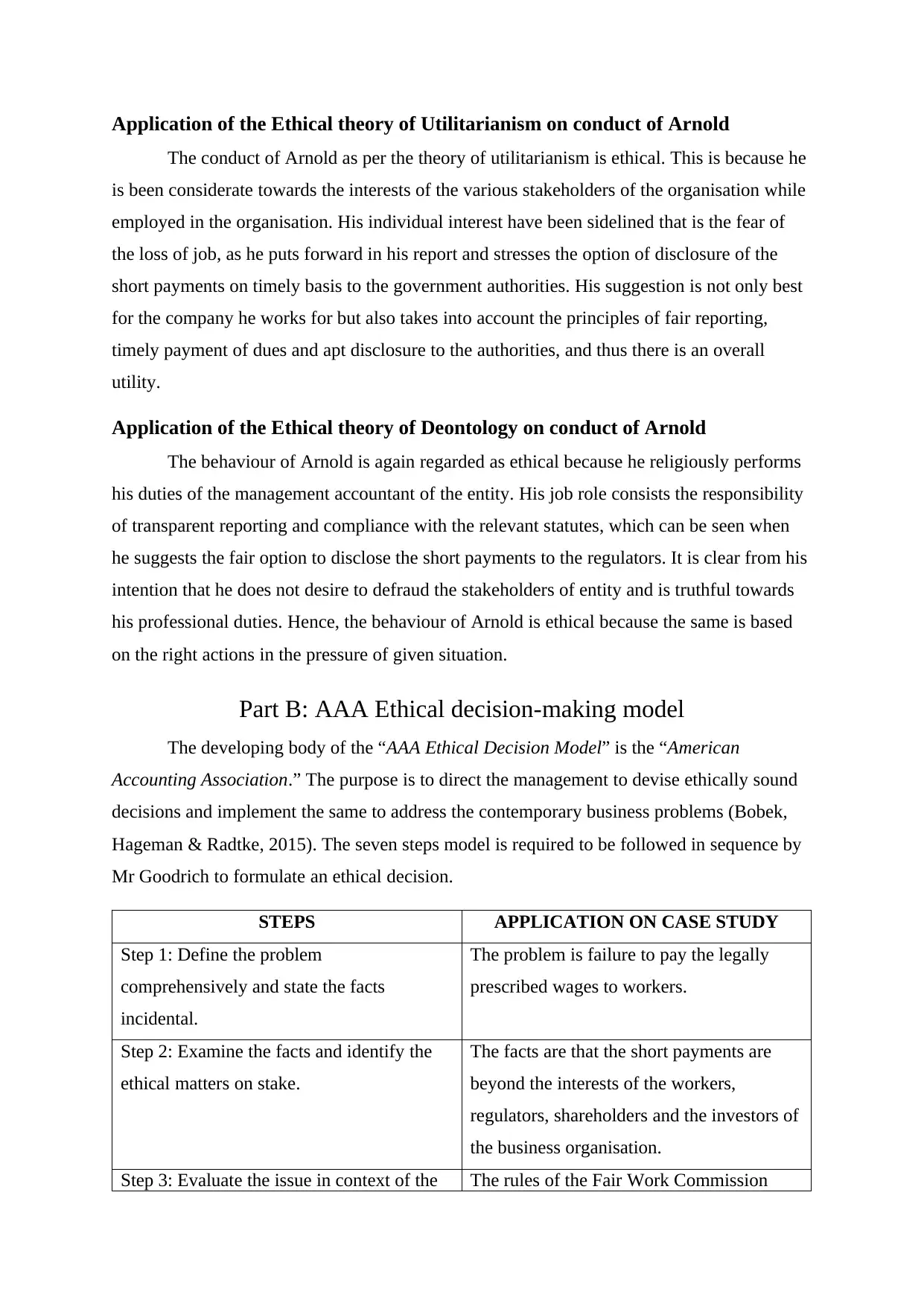
Application of the Ethical theory of Utilitarianism on conduct of Arnold
The conduct of Arnold as per the theory of utilitarianism is ethical. This is because he
is been considerate towards the interests of the various stakeholders of the organisation while
employed in the organisation. His individual interest have been sidelined that is the fear of
the loss of job, as he puts forward in his report and stresses the option of disclosure of the
short payments on timely basis to the government authorities. His suggestion is not only best
for the company he works for but also takes into account the principles of fair reporting,
timely payment of dues and apt disclosure to the authorities, and thus there is an overall
utility.
Application of the Ethical theory of Deontology on conduct of Arnold
The behaviour of Arnold is again regarded as ethical because he religiously performs
his duties of the management accountant of the entity. His job role consists the responsibility
of transparent reporting and compliance with the relevant statutes, which can be seen when
he suggests the fair option to disclose the short payments to the regulators. It is clear from his
intention that he does not desire to defraud the stakeholders of entity and is truthful towards
his professional duties. Hence, the behaviour of Arnold is ethical because the same is based
on the right actions in the pressure of given situation.
Part B: AAA Ethical decision-making model
The developing body of the “AAA Ethical Decision Model” is the “American
Accounting Association.” The purpose is to direct the management to devise ethically sound
decisions and implement the same to address the contemporary business problems (Bobek,
Hageman & Radtke, 2015). The seven steps model is required to be followed in sequence by
Mr Goodrich to formulate an ethical decision.
STEPS APPLICATION ON CASE STUDY
Step 1: Define the problem
comprehensively and state the facts
incidental.
The problem is failure to pay the legally
prescribed wages to workers.
Step 2: Examine the facts and identify the
ethical matters on stake.
The facts are that the short payments are
beyond the interests of the workers,
regulators, shareholders and the investors of
the business organisation.
Step 3: Evaluate the issue in context of the The rules of the Fair Work Commission
The conduct of Arnold as per the theory of utilitarianism is ethical. This is because he
is been considerate towards the interests of the various stakeholders of the organisation while
employed in the organisation. His individual interest have been sidelined that is the fear of
the loss of job, as he puts forward in his report and stresses the option of disclosure of the
short payments on timely basis to the government authorities. His suggestion is not only best
for the company he works for but also takes into account the principles of fair reporting,
timely payment of dues and apt disclosure to the authorities, and thus there is an overall
utility.
Application of the Ethical theory of Deontology on conduct of Arnold
The behaviour of Arnold is again regarded as ethical because he religiously performs
his duties of the management accountant of the entity. His job role consists the responsibility
of transparent reporting and compliance with the relevant statutes, which can be seen when
he suggests the fair option to disclose the short payments to the regulators. It is clear from his
intention that he does not desire to defraud the stakeholders of entity and is truthful towards
his professional duties. Hence, the behaviour of Arnold is ethical because the same is based
on the right actions in the pressure of given situation.
Part B: AAA Ethical decision-making model
The developing body of the “AAA Ethical Decision Model” is the “American
Accounting Association.” The purpose is to direct the management to devise ethically sound
decisions and implement the same to address the contemporary business problems (Bobek,
Hageman & Radtke, 2015). The seven steps model is required to be followed in sequence by
Mr Goodrich to formulate an ethical decision.
STEPS APPLICATION ON CASE STUDY
Step 1: Define the problem
comprehensively and state the facts
incidental.
The problem is failure to pay the legally
prescribed wages to workers.
Step 2: Examine the facts and identify the
ethical matters on stake.
The facts are that the short payments are
beyond the interests of the workers,
regulators, shareholders and the investors of
the business organisation.
Step 3: Evaluate the issue in context of the The rules of the Fair Work Commission
⊘ This is a preview!⊘
Do you want full access?
Subscribe today to unlock all pages.

Trusted by 1+ million students worldwide
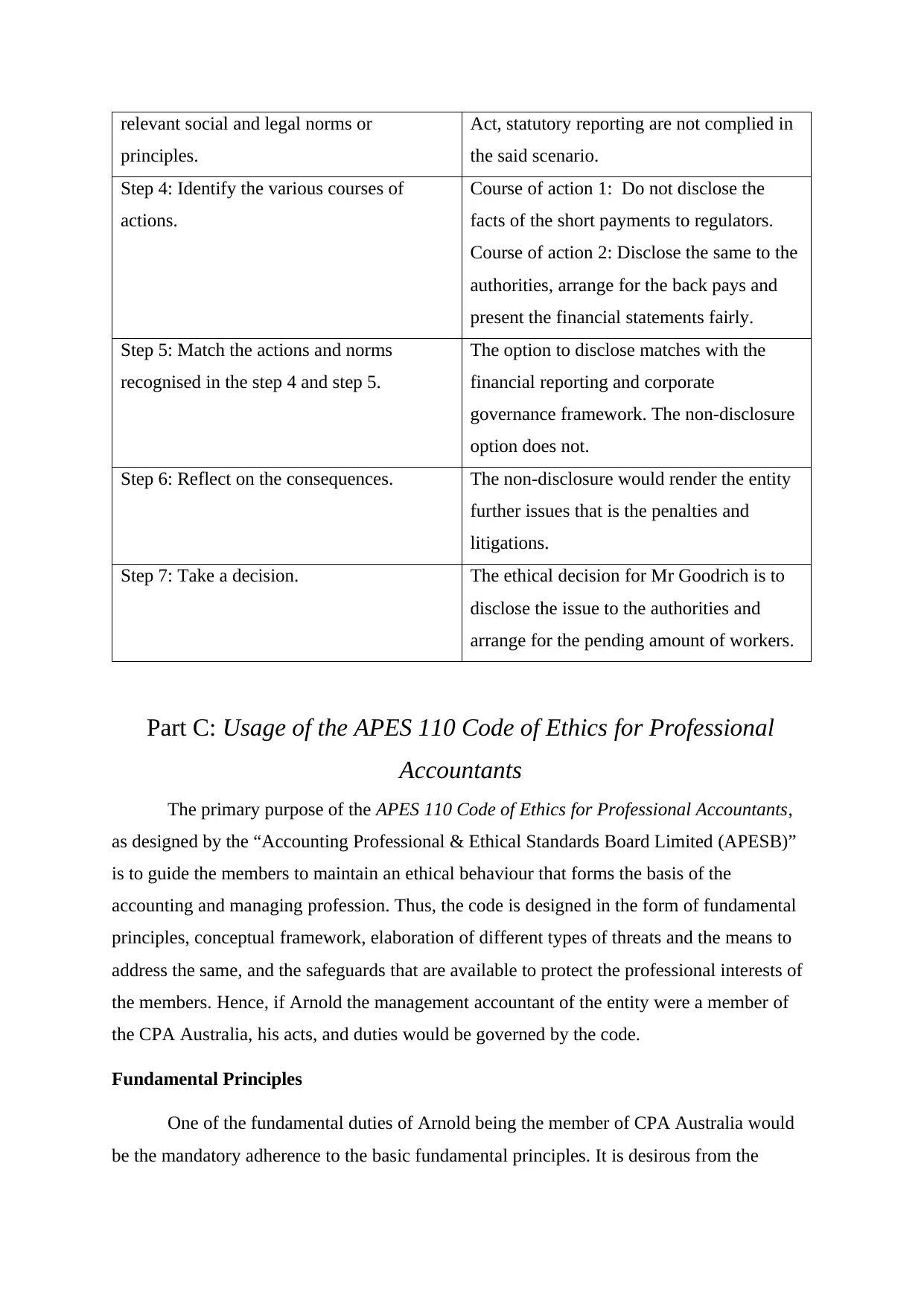
relevant social and legal norms or
principles.
Act, statutory reporting are not complied in
the said scenario.
Step 4: Identify the various courses of
actions.
Course of action 1: Do not disclose the
facts of the short payments to regulators.
Course of action 2: Disclose the same to the
authorities, arrange for the back pays and
present the financial statements fairly.
Step 5: Match the actions and norms
recognised in the step 4 and step 5.
The option to disclose matches with the
financial reporting and corporate
governance framework. The non-disclosure
option does not.
Step 6: Reflect on the consequences. The non-disclosure would render the entity
further issues that is the penalties and
litigations.
Step 7: Take a decision. The ethical decision for Mr Goodrich is to
disclose the issue to the authorities and
arrange for the pending amount of workers.
Part C: Usage of the APES 110 Code of Ethics for Professional
Accountants
The primary purpose of the APES 110 Code of Ethics for Professional Accountants,
as designed by the “Accounting Professional & Ethical Standards Board Limited (APESB)”
is to guide the members to maintain an ethical behaviour that forms the basis of the
accounting and managing profession. Thus, the code is designed in the form of fundamental
principles, conceptual framework, elaboration of different types of threats and the means to
address the same, and the safeguards that are available to protect the professional interests of
the members. Hence, if Arnold the management accountant of the entity were a member of
the CPA Australia, his acts, and duties would be governed by the code.
Fundamental Principles
One of the fundamental duties of Arnold being the member of CPA Australia would
be the mandatory adherence to the basic fundamental principles. It is desirous from the
principles.
Act, statutory reporting are not complied in
the said scenario.
Step 4: Identify the various courses of
actions.
Course of action 1: Do not disclose the
facts of the short payments to regulators.
Course of action 2: Disclose the same to the
authorities, arrange for the back pays and
present the financial statements fairly.
Step 5: Match the actions and norms
recognised in the step 4 and step 5.
The option to disclose matches with the
financial reporting and corporate
governance framework. The non-disclosure
option does not.
Step 6: Reflect on the consequences. The non-disclosure would render the entity
further issues that is the penalties and
litigations.
Step 7: Take a decision. The ethical decision for Mr Goodrich is to
disclose the issue to the authorities and
arrange for the pending amount of workers.
Part C: Usage of the APES 110 Code of Ethics for Professional
Accountants
The primary purpose of the APES 110 Code of Ethics for Professional Accountants,
as designed by the “Accounting Professional & Ethical Standards Board Limited (APESB)”
is to guide the members to maintain an ethical behaviour that forms the basis of the
accounting and managing profession. Thus, the code is designed in the form of fundamental
principles, conceptual framework, elaboration of different types of threats and the means to
address the same, and the safeguards that are available to protect the professional interests of
the members. Hence, if Arnold the management accountant of the entity were a member of
the CPA Australia, his acts, and duties would be governed by the code.
Fundamental Principles
One of the fundamental duties of Arnold being the member of CPA Australia would
be the mandatory adherence to the basic fundamental principles. It is desirous from the
Paraphrase This Document
Need a fresh take? Get an instant paraphrase of this document with our AI Paraphraser
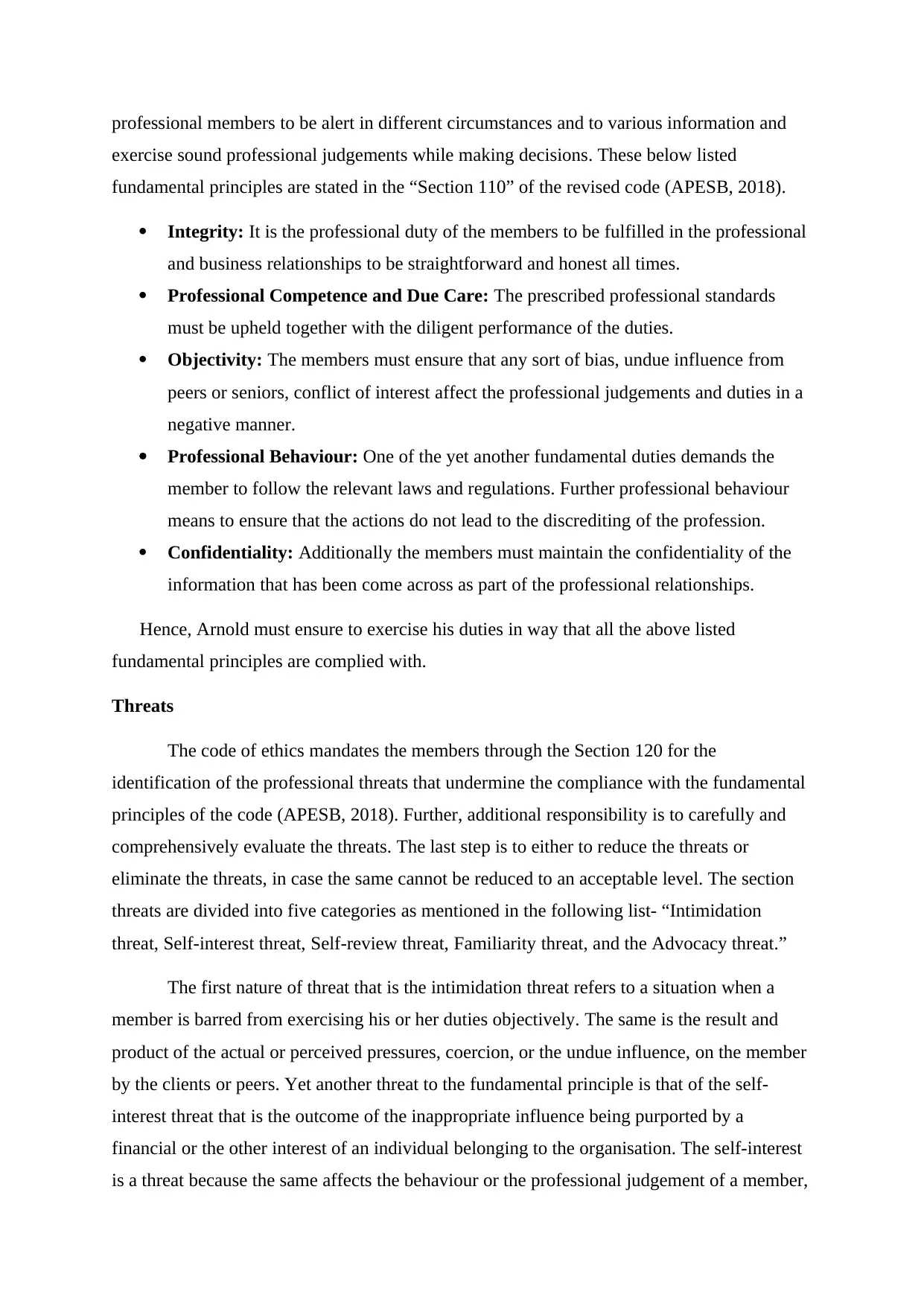
professional members to be alert in different circumstances and to various information and
exercise sound professional judgements while making decisions. These below listed
fundamental principles are stated in the “Section 110” of the revised code (APESB, 2018).
Integrity: It is the professional duty of the members to be fulfilled in the professional
and business relationships to be straightforward and honest all times.
Professional Competence and Due Care: The prescribed professional standards
must be upheld together with the diligent performance of the duties.
Objectivity: The members must ensure that any sort of bias, undue influence from
peers or seniors, conflict of interest affect the professional judgements and duties in a
negative manner.
Professional Behaviour: One of the yet another fundamental duties demands the
member to follow the relevant laws and regulations. Further professional behaviour
means to ensure that the actions do not lead to the discrediting of the profession.
Confidentiality: Additionally the members must maintain the confidentiality of the
information that has been come across as part of the professional relationships.
Hence, Arnold must ensure to exercise his duties in way that all the above listed
fundamental principles are complied with.
Threats
The code of ethics mandates the members through the Section 120 for the
identification of the professional threats that undermine the compliance with the fundamental
principles of the code (APESB, 2018). Further, additional responsibility is to carefully and
comprehensively evaluate the threats. The last step is to either to reduce the threats or
eliminate the threats, in case the same cannot be reduced to an acceptable level. The section
threats are divided into five categories as mentioned in the following list- “Intimidation
threat, Self-interest threat, Self-review threat, Familiarity threat, and the Advocacy threat.”
The first nature of threat that is the intimidation threat refers to a situation when a
member is barred from exercising his or her duties objectively. The same is the result and
product of the actual or perceived pressures, coercion, or the undue influence, on the member
by the clients or peers. Yet another threat to the fundamental principle is that of the self-
interest threat that is the outcome of the inappropriate influence being purported by a
financial or the other interest of an individual belonging to the organisation. The self-interest
is a threat because the same affects the behaviour or the professional judgement of a member,
exercise sound professional judgements while making decisions. These below listed
fundamental principles are stated in the “Section 110” of the revised code (APESB, 2018).
Integrity: It is the professional duty of the members to be fulfilled in the professional
and business relationships to be straightforward and honest all times.
Professional Competence and Due Care: The prescribed professional standards
must be upheld together with the diligent performance of the duties.
Objectivity: The members must ensure that any sort of bias, undue influence from
peers or seniors, conflict of interest affect the professional judgements and duties in a
negative manner.
Professional Behaviour: One of the yet another fundamental duties demands the
member to follow the relevant laws and regulations. Further professional behaviour
means to ensure that the actions do not lead to the discrediting of the profession.
Confidentiality: Additionally the members must maintain the confidentiality of the
information that has been come across as part of the professional relationships.
Hence, Arnold must ensure to exercise his duties in way that all the above listed
fundamental principles are complied with.
Threats
The code of ethics mandates the members through the Section 120 for the
identification of the professional threats that undermine the compliance with the fundamental
principles of the code (APESB, 2018). Further, additional responsibility is to carefully and
comprehensively evaluate the threats. The last step is to either to reduce the threats or
eliminate the threats, in case the same cannot be reduced to an acceptable level. The section
threats are divided into five categories as mentioned in the following list- “Intimidation
threat, Self-interest threat, Self-review threat, Familiarity threat, and the Advocacy threat.”
The first nature of threat that is the intimidation threat refers to a situation when a
member is barred from exercising his or her duties objectively. The same is the result and
product of the actual or perceived pressures, coercion, or the undue influence, on the member
by the clients or peers. Yet another threat to the fundamental principle is that of the self-
interest threat that is the outcome of the inappropriate influence being purported by a
financial or the other interest of an individual belonging to the organisation. The self-interest
is a threat because the same affects the behaviour or the professional judgement of a member,
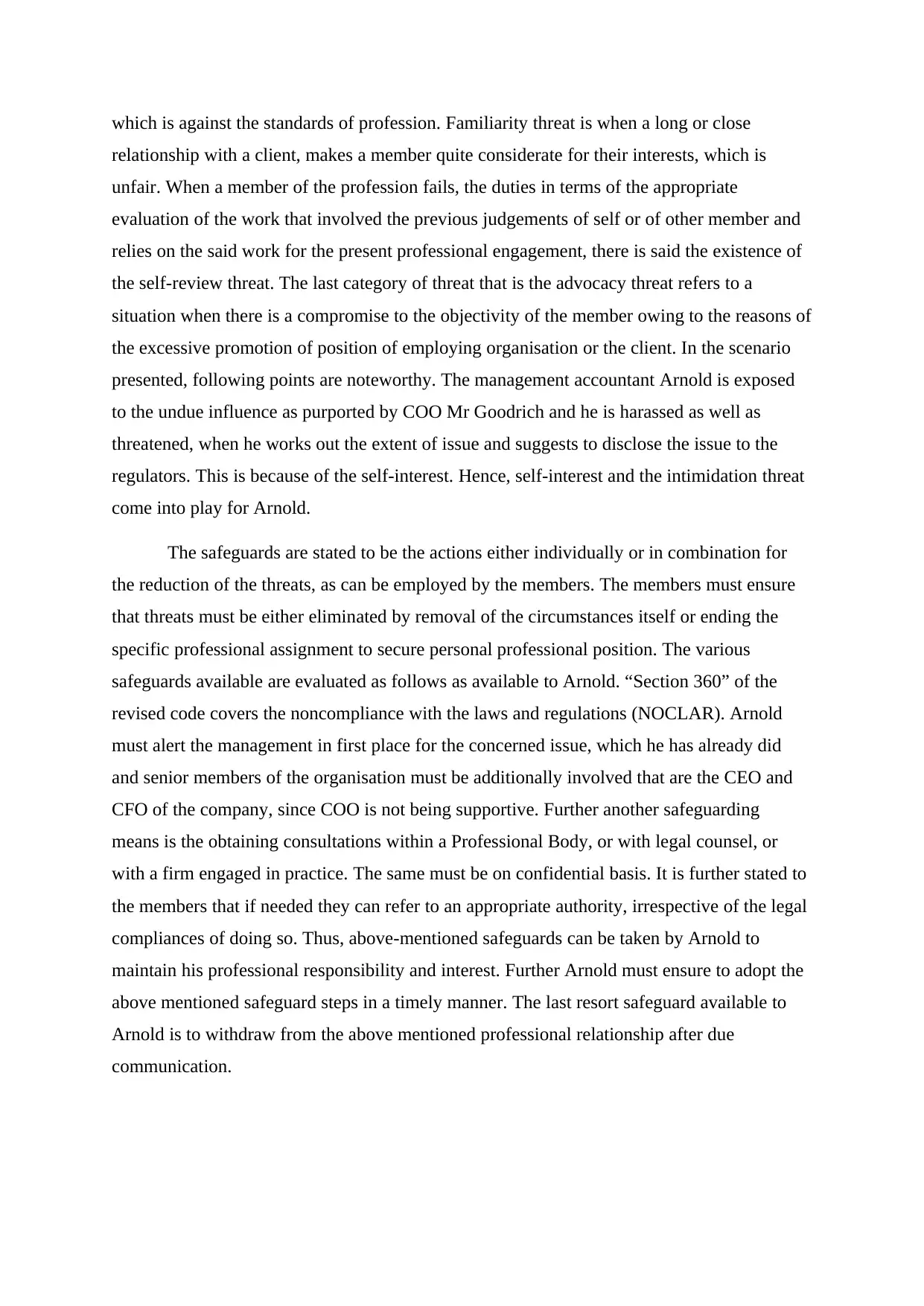
which is against the standards of profession. Familiarity threat is when a long or close
relationship with a client, makes a member quite considerate for their interests, which is
unfair. When a member of the profession fails, the duties in terms of the appropriate
evaluation of the work that involved the previous judgements of self or of other member and
relies on the said work for the present professional engagement, there is said the existence of
the self-review threat. The last category of threat that is the advocacy threat refers to a
situation when there is a compromise to the objectivity of the member owing to the reasons of
the excessive promotion of position of employing organisation or the client. In the scenario
presented, following points are noteworthy. The management accountant Arnold is exposed
to the undue influence as purported by COO Mr Goodrich and he is harassed as well as
threatened, when he works out the extent of issue and suggests to disclose the issue to the
regulators. This is because of the self-interest. Hence, self-interest and the intimidation threat
come into play for Arnold.
The safeguards are stated to be the actions either individually or in combination for
the reduction of the threats, as can be employed by the members. The members must ensure
that threats must be either eliminated by removal of the circumstances itself or ending the
specific professional assignment to secure personal professional position. The various
safeguards available are evaluated as follows as available to Arnold. “Section 360” of the
revised code covers the noncompliance with the laws and regulations (NOCLAR). Arnold
must alert the management in first place for the concerned issue, which he has already did
and senior members of the organisation must be additionally involved that are the CEO and
CFO of the company, since COO is not being supportive. Further another safeguarding
means is the obtaining consultations within a Professional Body, or with legal counsel, or
with a firm engaged in practice. The same must be on confidential basis. It is further stated to
the members that if needed they can refer to an appropriate authority, irrespective of the legal
compliances of doing so. Thus, above-mentioned safeguards can be taken by Arnold to
maintain his professional responsibility and interest. Further Arnold must ensure to adopt the
above mentioned safeguard steps in a timely manner. The last resort safeguard available to
Arnold is to withdraw from the above mentioned professional relationship after due
communication.
relationship with a client, makes a member quite considerate for their interests, which is
unfair. When a member of the profession fails, the duties in terms of the appropriate
evaluation of the work that involved the previous judgements of self or of other member and
relies on the said work for the present professional engagement, there is said the existence of
the self-review threat. The last category of threat that is the advocacy threat refers to a
situation when there is a compromise to the objectivity of the member owing to the reasons of
the excessive promotion of position of employing organisation or the client. In the scenario
presented, following points are noteworthy. The management accountant Arnold is exposed
to the undue influence as purported by COO Mr Goodrich and he is harassed as well as
threatened, when he works out the extent of issue and suggests to disclose the issue to the
regulators. This is because of the self-interest. Hence, self-interest and the intimidation threat
come into play for Arnold.
The safeguards are stated to be the actions either individually or in combination for
the reduction of the threats, as can be employed by the members. The members must ensure
that threats must be either eliminated by removal of the circumstances itself or ending the
specific professional assignment to secure personal professional position. The various
safeguards available are evaluated as follows as available to Arnold. “Section 360” of the
revised code covers the noncompliance with the laws and regulations (NOCLAR). Arnold
must alert the management in first place for the concerned issue, which he has already did
and senior members of the organisation must be additionally involved that are the CEO and
CFO of the company, since COO is not being supportive. Further another safeguarding
means is the obtaining consultations within a Professional Body, or with legal counsel, or
with a firm engaged in practice. The same must be on confidential basis. It is further stated to
the members that if needed they can refer to an appropriate authority, irrespective of the legal
compliances of doing so. Thus, above-mentioned safeguards can be taken by Arnold to
maintain his professional responsibility and interest. Further Arnold must ensure to adopt the
above mentioned safeguard steps in a timely manner. The last resort safeguard available to
Arnold is to withdraw from the above mentioned professional relationship after due
communication.
⊘ This is a preview!⊘
Do you want full access?
Subscribe today to unlock all pages.

Trusted by 1+ million students worldwide
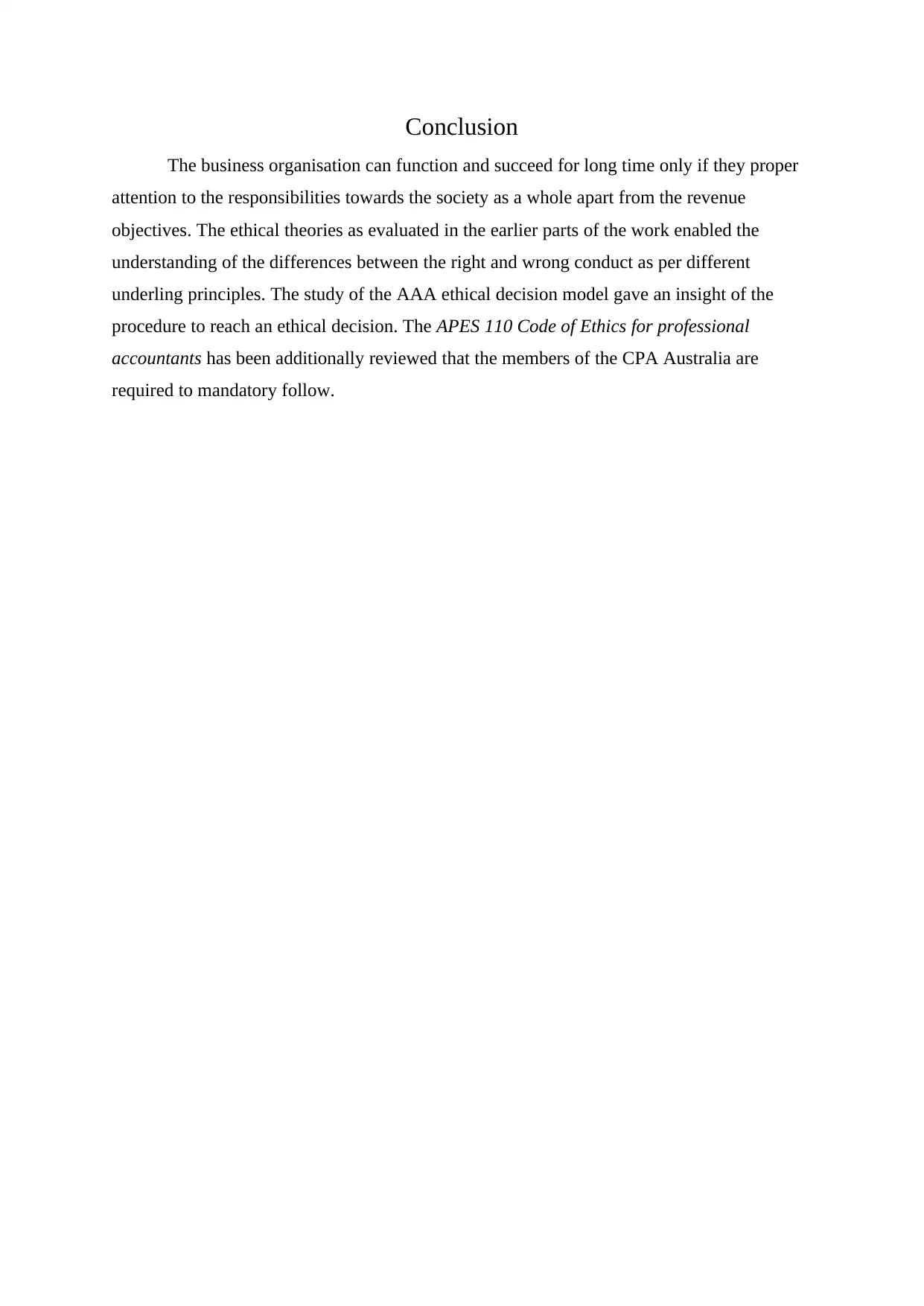
Conclusion
The business organisation can function and succeed for long time only if they proper
attention to the responsibilities towards the society as a whole apart from the revenue
objectives. The ethical theories as evaluated in the earlier parts of the work enabled the
understanding of the differences between the right and wrong conduct as per different
underling principles. The study of the AAA ethical decision model gave an insight of the
procedure to reach an ethical decision. The APES 110 Code of Ethics for professional
accountants has been additionally reviewed that the members of the CPA Australia are
required to mandatory follow.
The business organisation can function and succeed for long time only if they proper
attention to the responsibilities towards the society as a whole apart from the revenue
objectives. The ethical theories as evaluated in the earlier parts of the work enabled the
understanding of the differences between the right and wrong conduct as per different
underling principles. The study of the AAA ethical decision model gave an insight of the
procedure to reach an ethical decision. The APES 110 Code of Ethics for professional
accountants has been additionally reviewed that the members of the CPA Australia are
required to mandatory follow.
Paraphrase This Document
Need a fresh take? Get an instant paraphrase of this document with our AI Paraphraser
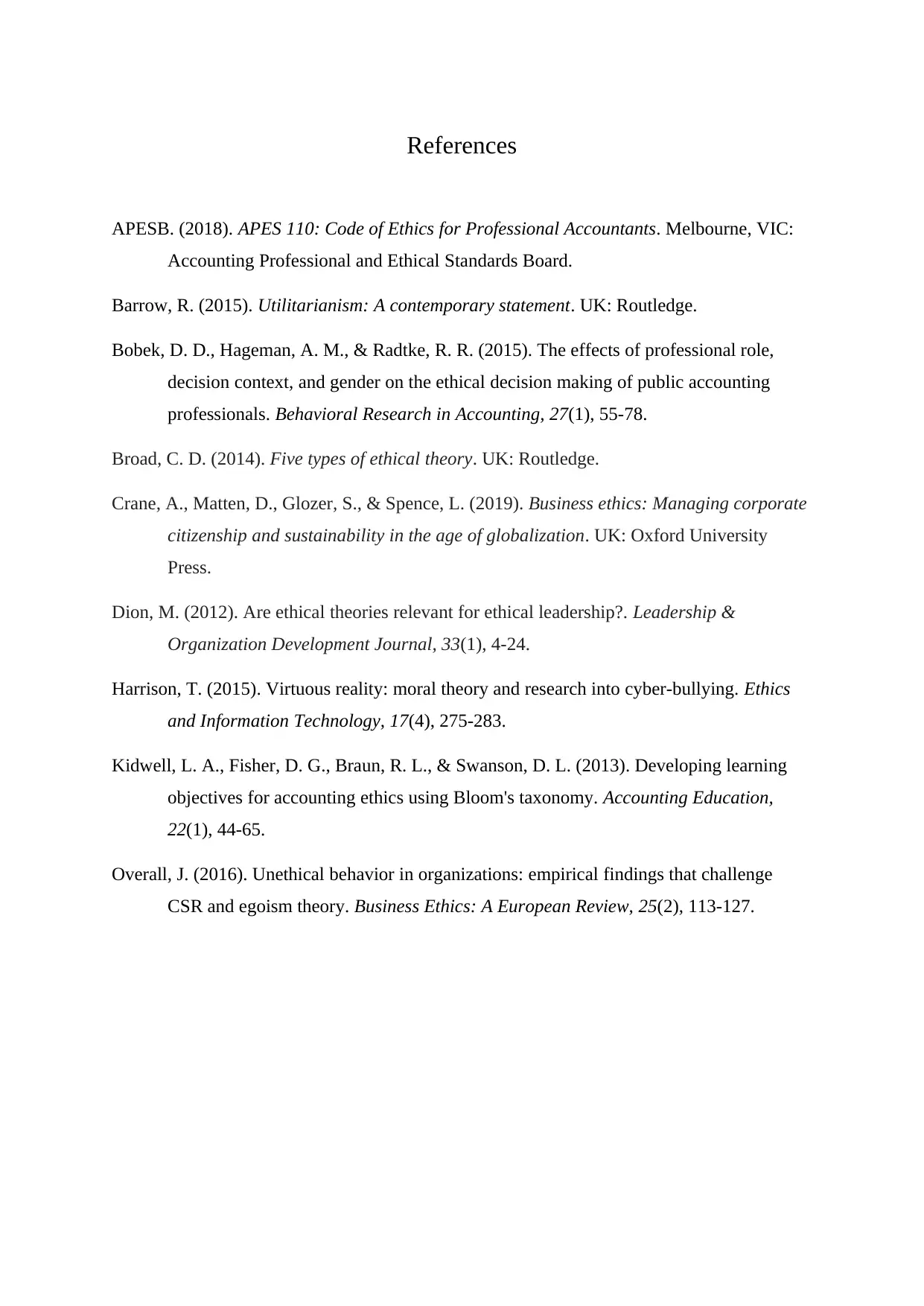
References
APESB. (2018). APES 110: Code of Ethics for Professional Accountants. Melbourne, VIC:
Accounting Professional and Ethical Standards Board.
Barrow, R. (2015). Utilitarianism: A contemporary statement. UK: Routledge.
Bobek, D. D., Hageman, A. M., & Radtke, R. R. (2015). The effects of professional role,
decision context, and gender on the ethical decision making of public accounting
professionals. Behavioral Research in Accounting, 27(1), 55-78.
Broad, C. D. (2014). Five types of ethical theory. UK: Routledge.
Crane, A., Matten, D., Glozer, S., & Spence, L. (2019). Business ethics: Managing corporate
citizenship and sustainability in the age of globalization. UK: Oxford University
Press.
Dion, M. (2012). Are ethical theories relevant for ethical leadership?. Leadership &
Organization Development Journal, 33(1), 4-24.
Harrison, T. (2015). Virtuous reality: moral theory and research into cyber-bullying. Ethics
and Information Technology, 17(4), 275-283.
Kidwell, L. A., Fisher, D. G., Braun, R. L., & Swanson, D. L. (2013). Developing learning
objectives for accounting ethics using Bloom's taxonomy. Accounting Education,
22(1), 44-65.
Overall, J. (2016). Unethical behavior in organizations: empirical findings that challenge
CSR and egoism theory. Business Ethics: A European Review, 25(2), 113-127.
APESB. (2018). APES 110: Code of Ethics for Professional Accountants. Melbourne, VIC:
Accounting Professional and Ethical Standards Board.
Barrow, R. (2015). Utilitarianism: A contemporary statement. UK: Routledge.
Bobek, D. D., Hageman, A. M., & Radtke, R. R. (2015). The effects of professional role,
decision context, and gender on the ethical decision making of public accounting
professionals. Behavioral Research in Accounting, 27(1), 55-78.
Broad, C. D. (2014). Five types of ethical theory. UK: Routledge.
Crane, A., Matten, D., Glozer, S., & Spence, L. (2019). Business ethics: Managing corporate
citizenship and sustainability in the age of globalization. UK: Oxford University
Press.
Dion, M. (2012). Are ethical theories relevant for ethical leadership?. Leadership &
Organization Development Journal, 33(1), 4-24.
Harrison, T. (2015). Virtuous reality: moral theory and research into cyber-bullying. Ethics
and Information Technology, 17(4), 275-283.
Kidwell, L. A., Fisher, D. G., Braun, R. L., & Swanson, D. L. (2013). Developing learning
objectives for accounting ethics using Bloom's taxonomy. Accounting Education,
22(1), 44-65.
Overall, J. (2016). Unethical behavior in organizations: empirical findings that challenge
CSR and egoism theory. Business Ethics: A European Review, 25(2), 113-127.

⊘ This is a preview!⊘
Do you want full access?
Subscribe today to unlock all pages.

Trusted by 1+ million students worldwide
1 out of 12
Related Documents
Your All-in-One AI-Powered Toolkit for Academic Success.
+13062052269
info@desklib.com
Available 24*7 on WhatsApp / Email
![[object Object]](/_next/static/media/star-bottom.7253800d.svg)
Unlock your academic potential
Copyright © 2020–2025 A2Z Services. All Rights Reserved. Developed and managed by ZUCOL.





